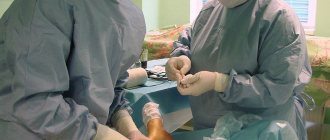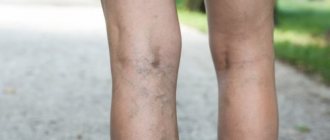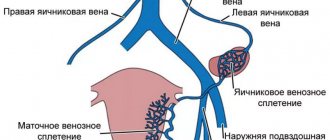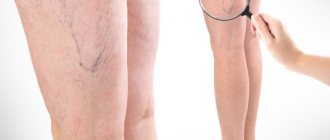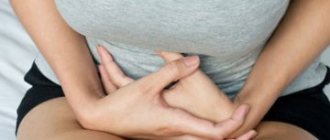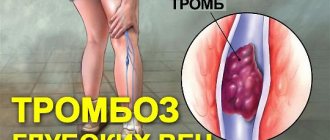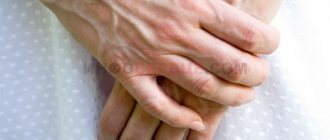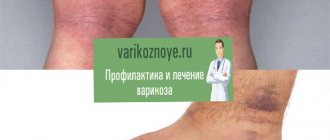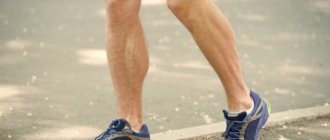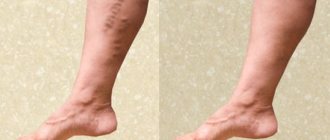Varicose veins of the lower extremities. Causes of the disease (Wikipedia and the official approach):
There are primary and secondary varicose veins of the lower extremities. Secondary develops as a result of injuries, tumors, etc., when the venous system cannot fully perform its functions.
Occupations in which varicose veins most often develop
Primary develops due to weakness of the venous wall. Reasons that contribute to the development of varicose veins of the lower extremities:
- pregnancy;
- hormonal imbalance;
- heavy static loads;
- smoking;
- work that requires standing for long periods of time (for example, hairdressers, salespeople, waiters);
- sitting in an incorrect position, especially crossing your legs;
- high-heeled shoes;
- sedentary lifestyle.
All these factors contribute to a deterioration in the outflow of blood from the lower extremities, thereby the superficial veins become overfilled, dilate, and blood stagnation occurs. Heredity plays an important role in the development of the disease.
Forecast
Stages of varicose veins.
An unfavorable prognosis is observed in the case of pulmonary embolism, the number of deaths in which reaches 75%. Thrombophlebitis with trophic skin lesions also has an unpromising characteristic, since with this disease persistent vascular changes occur, and the risk of infection increases, which leads to a number of complications. The consequences of an illness can often lead to disability.
Indications for granting a patient a disability status are:
- presence of thrombosis and previous thromboembolism;
- recurrent erysipelas;
- postthrombophlebitic syndrome;
- ineffective surgical treatment.
Most often, disability is given to patients with the last stage of varicose veins with persistent impairment of performance.
Varicose veins of the lower extremities - symptoms
Varicose veins of the lower extremities are accompanied by the following symptoms:
- swelling of the legs at the end of the working day;
- feeling of heaviness in the legs;
- cramps in the calf muscles, mainly at night;
- pain, burning sensation in the legs;
- spider veins on the legs;
- formation of trophic ulcers.
Spider veins are small red-blue nodules on the skin that can be seen on the legs at the very beginning of the disease. Often, varicose veins of the lower extremities during pregnancy cause particular discomfort.
Other consequences of varicose veins
Thrombophlebitis. Often varicose veins and venous insufficiency lead to inflammation of the walls of blood vessels - phlebitis, which can be combined with the formation of blood clots - thrombophlebitis. Basically, this disease affects the vessels of the lower extremities, as a result of which patients complain of severe pain in the affected areas of the legs.
Thromboembolism. In the presence of thrombophlebitis and varicose veins, there is a risk of developing a serious complication - thromboembolism. It occurs due to the separation of a blood clot from the wall of a vessel, followed by blockage of the most important trunks that feed the heart, lungs and brain.
Thrombophlebitis of the lower extremities.
Initially, the blood clot may be located, for example, in the leg (this is the most common). However, from the lower limb it is forced to move through the bloodstream to various parts of the body. As a result, getting into smaller branches of the vascular system, the thrombus causes collapse, as a result of which the blood circulation of the area is disrupted with the appearance of ischemia and then necrosis. Clinically, this manifests itself as a heart attack, stroke or PE (pulmonary embolism), which is often fatal.
Treatment of patients diagnosed with this should only be carried out in intensive care units. Measures to help the patient in this case must be taken immediately - only in this case does the patient have a chance of salvation.
Dermatitis. Most often, this unpleasant complication occurs on the inner surface of the lower leg and is manifested by a number of symptoms, which include:
- thinning of the skin;
- epidermal pigmentation;
- itching of the affected area;
- the appearance of bubbles that tend to “open up”, which leads to skin separation;
- loss of sensitivity in the affected area.
Telangiectasia. This cosmetic defect, which looks like spider veins, is a consequence of ruptures of small surface capillaries and a sign of the initial stage of varicose veins.
Dermatitis on the legs.
Haemorrhoids. This is a very common disease - nothing more than varicose veins of the rectum. It is manifested by the appearance of so-called hemorrhoids, which are often able to come out, rupture and become inflamed. This causes significant anxiety for patients.
We suggest that you familiarize yourself with what antithrombosis tablets (medicines) to take to resolve blood clots in blood vessels and how to treat venous thrombosis
Varicose veins of the lower extremities - stages
There are several stages of disease development:
- compensation – spider veins and tortuous veins appear on the legs, no complaints
- subcompensation – there are complaints of swelling, cramps of the calf muscles, a feeling of heaviness, fatigue in the legs, pronounced dilated veins are visually determined
- decompensation – dermatitis, minor hemorrhages are added, the skin becomes dense, dry, easily wounded, pigment spots appear
The earlier the disease is detected, the easier it is to treat.
Varicose veins in men and their features
At a young age (on average, 10-12 years), a young man may encounter a disease such as varicose veins of the scrotum. Scientifically, this condition is called “Varicocele”. It can be detected during simple inspection and palpation of the scrotum. Clinically, varicocele is manifested by a number of symptoms, including:
- pain in the side or half of the affected scrotum, worsening after physical activity;
- heaviness in the testicle;
- infertility.
However, often a varicocele may not manifest itself at all and may be discovered by chance during a routine examination.
This disease has three stages:
- Slight expansion of the veins, which can be noticed when the patient performs the Valsalva maneuver (straining);
- The veins are visible and palpable when the patient is at rest;
- The vessels are sharply changed, tortuous, filled with blood. The testicle in the affected area is reduced in size and has a doughy consistency.
In adult patients, varicose veins of the scrotum are often diagnosed when visiting a doctor with complaints about the inability to have a child. There is a theory that varicocele affects fertility (the ability to reproduce) by increasing the temperature inside the scrotum, which has a detrimental effect on the testicle and spermatogenesis. Moreover, this type of varicose veins in men is often combined with damage to blood vessels in the legs.
Diagnosis of the disease is simple. As mentioned earlier, varicose veins of the scrotum can be suspected during a routine examination, and then an ultrasound examination of the vascular bundle should be done to confirm. Only surgical intervention is used as a treatment method: the doctor simply ties the varicose veins, blood circulation is carried out through anastomoses. However, it should be borne in mind that, as with varicose veins of the legs, surgery does not guarantee complete healing. Moreover, the disease recurs in many cases.
Varicose veins of the lower extremities - diagnosis
To accurately diagnose the disease, you must consult a doctor. Vascular surgery deals with varicose veins of the lower extremities. To make a diagnosis, in addition to complaints and visual examination, it is necessary to use special research methods.
Ultrasound diagnosis of varicose veins of the lower extremities
Duplex angioscanning is considered the gold standard. This method combines ultrasound and Doppler scanning. Thus, it is possible to see the condition of the vascular wall in real time and assess the speed of blood flow in the venous system of the lower extremities.
Varicose veins of the lower extremities - complications
If there are varicose veins of the lower extremities, treatment should begin faster, otherwise the disease will progress, which is fraught with serious complications. Stagnation of blood in the veins contributes to the formation of blood clots, phlebothrombosis develops, and if the vein also becomes inflamed, thrombophlebitis develops.
Acute thrombophlebitis of superficial veins
The resulting blood clots can break free from their place at any time and enter the bloodstream. In this case, the blood clot enters the veins of the lungs, blocking them. In this case, a person can die from suffocation even before the ambulance arrives, because such a formidable complication is extremely difficult to treat even in a specialized hospital, and there is very little time to save a life.
In addition, due to blood stagnation, nutrition of the lower extremities is disrupted. Deep trophic ulcers form on the skin, which heal poorly and tend to spread. This can lead to amputation of the limb.
Based on the fact that complications of varicose veins of the lower extremities are not at all harmless, it is necessary to contact a qualified specialist as soon as possible. Only a doctor can prescribe effective treatment and help avoid complications.
Features of varicose veins in women
Pelvic varicose veins. For women, this disease is a risk of miscarriage. As mentioned above, varicose veins can occur in any part of the body, including in the pelvic area. During pregnancy, the situation is aggravated, since, firstly, the vessels of the abdominal cavity stretch as the fetus grows, and secondly, they are under pressure from the increasing size of the uterus. As a result of these processes, the blood circulation of the placenta is disrupted, which can lead to its rejection. In this case, naturally, the likelihood of losing a child increases significantly.
Varicose veins of the lower extremities - how to treat with ointments
In the pharmacy you can find a huge number of ointments for varicose veins of the lower extremities. They are based on substances that improve tissue trophism, relieve swelling and strengthen the vascular wall. Varicose veins of the lower extremities, photos and reviews of ointments are available on the drug pages on the Internet.
Treatment of varicose veins with ointments and gels
In the early stages of the development of the disease, the use of various ointments can improve the condition of the venous system and slow down the progression of the disease, but it will not be possible to completely defeat varicose veins of the lower extremities. The results will be available only after visiting a doctor.
Varicose veins of the lower extremities - treatment: surgery or still a procedure?
- Intravascular coagulation. Do you have varicose veins of the lower extremities? Laser treatment in Moscow is a small endovascular operation during which a vein is obliterated with a laser. Varicose veins of the lower extremities will be removed; laser treatment is based on the introduction of blood flow into the desired vein. This is how varicose veins of the lower extremities are defeated. Laser treatment, the cost of which is not so high, takes little time and is well tolerated by patients, and they forget that they had varicose veins of the lower extremities; laser treatment (the price in our center is affordable) is very effective. The final figure depends on the stage of the disease and the amount of work the doctor does. Do not be afraid that varicose veins of the lower extremities will attack again later. Laser treatment (there are quite a lot of reviews!) will definitely put you “on your feet”!
- Short stripping is a minimally invasive technique in which a small section of the affected main vein is removed. In this way, it is possible to preserve as many healthy sections of veins as possible.
- Cryophlebectomy – removal of a vein using a cryoprobe. The operation is low-traumatic - however, one small incision is made to insert the probe. After the operation, you see results immediately.
Concept of varicose veins
Varicose veins are a disease that affects the muscle and connective tissue layer of the vascular wall, as well as their valve apparatus. As a result, the veins dilate, blood circulation in this place is impaired, and blood flows back through the vessels.
Most people are aware of varicose veins in the legs. But there are other localizations of the disease, since blood vessels can be affected anywhere in the body.
Most often in medical practice, varicose veins of the pelvic organs (bladder, uterus), and perineum (scrotum, rectum, vagina) are diagnosed. However, in any case, the clinical picture of the disease depends on the location of the lesion and the stage of the pathology.
Varicose veins of the lower extremities - treatment with radiofrequency
How to remove varicose veins of the lower extremities? RFA treatment is of particular interest to patients. Why do many people dream of eliminating varicose veins of the lower extremities and prefer RFO treatment?
Radiofrequency ablation (RFA) is an operation that can be performed on an outpatient basis if you want to forget varicose veins of the lower extremities. RFA treatment in Moscow uses radio frequency, which is used to “seal” a vein and remove varicose veins of the lower extremities. RFO treatment in Moscow is fast and effective.
Caution - varicose veins of the lower extremities
Treatment with traditional methods (prices for herbs and creams differ), but still do not place too much hope on a green pharmacy.
Excess weight provokes the development of varicose veins
It is important to pay attention to nutrition if you have varicose veins of the lower extremities, treatment with traditional methods, the price of which is pennies. It is necessary to limit the consumption of meat, spicy, salty and smoked foods, increase the amount of vegetables and fruits in the diet and eliminate alcohol and coffee.
An optimal daily routine and therapeutic exercises will help improve blood circulation in the extremities. This will take 10-15 minutes a day.
Simple traditional methods of treatment can complement the complex of measures for the treatment of varicose veins. Rubbing the feet with horse chestnut tincture, apple cider vinegar, butter with garlic and many other remedies have been known since ancient times. They will ease varicose veins of the lower extremities, the cost, photos and results can be viewed on our website on the Internet.
Varicose veins of the lower extremities - prevention
For prevention, it is necessary first of all to adhere to the work regime. You cannot constantly be on your feet or sit in one position. From time to time it is worth taking short breaks to give your legs a rest.
After a hard day at work, you can massage your feet, after which it is advisable to put your feet on a raised platform. This improves blood flow from the extremities.
Exercises to improve venous blood flow in the legs
Don't get carried away with hot baths and saunas. To prevent varicose veins, it is much more useful to take a contrast shower and rinse your legs with cool water.
It is important to monitor your weight. Excess body weight increases the load on the venous system and contributes to the development of the disease.
If there is a predisposition to developing the disease, and it is not possible to eliminate all risk factors, it is better to engage in prevention. Even if the disease has already begun, do not despair. Varicose veins of the lower extremities are not a death sentence. By detecting the problem in a timely manner and contacting specialists, you can get rid of the disease and avoid serious complications.
We invite you to visit our specialist phlebologist and get rid of varicose veins in the early stages.
Who has it more often?
Much more often you can find explanations of why varicose veins on the legs of women are dangerous. The reason is that the disease is much more common in women. The main misconception is that many consider it simply an aesthetic defect, ignoring a number of possible serious complications that pose a danger to life.
What is the danger of varicose veins on the legs of men is also a very pressing question. According to statistics, the risk of developing cardiovascular diseases is higher in men, and blood viscosity can also sometimes be increased. In this case, blood clots and other significant complications often develop, to which men turn a blind eye. The result is that the percentage of deaths from thrombosis in men is several times higher than in women.
Frequently asked questions from our patients on the Internet about varicose veins of the lower extremities
Are varicose veins of the lower extremities dangerous during pregnancy? Anastasia from Belgorod is interested in:
Dear Anastasia! Varicose veins of the lower extremities during pregnancy carry certain risks of developing thromboembolic complications. Therefore, it is necessary to contact a phlebologist and follow his recommendations.
I have had varicose veins of the lower extremities for quite a long time, what surgery is best? Tamara from Ufa asks:
Dear Tamara! If you have varicose veins of the lower extremities, modern minimally invasive surgery will be optimal. The best methods today are thermoobliteration techniques (laser and radio frequency).
I was diagnosed with varicose veins of the lower extremities, how is the operation performed? Boris from St. Petersburg is interested in:
Dear Boris! You have been diagnosed with varicose veins of the lower extremities, and therefore surgery is indicated. In Russia there is no uniform approach to the choice of surgical treatment. There is a classic and outdated phlebectomy technique, with incisions and anesthesia. This operation is usually performed in public hospitals. In specialized phlebological centers, innovative techniques are used through puncture approaches (punctures). Such operations are performed on an outpatient basis, under local anesthesia, without incisions or pain.
Varicose veins of the lower extremities, what is it? Elena from Pskov is interested in:
Dear Elena! Varicose veins of the lower extremities are a chronic progressive disease, manifested by pathological dilation of venous vessels, disruption of the normal functioning of vein valves, which adversely affects blood flow. This condition often develops in people whose work and lifestyle are associated with prolonged static load.
Varicose veins of the lower extremities, what treatment is used? Natalya from Petrozavodsk is interested in:
Dear Natalia! When a diagnosis is made: varicose veins of the lower extremities, a fairly varied treatment is used. The conservative approach has many supporters, both among patients and doctors. But we must immediately clarify that treatment of varicose veins of the lower extremities cannot only be conservative. Modern treatment of varicose veins involves the use of innovative techniques that radically eliminate the pathology. You can see reviews from patients of our clinic on our website:
